By Philip Ollerenshaw
For many people the terms Ulster, Northern Ireland, and ‘the North’ conjure up images of communal conflict, sectarianism, and peace processes of indefinite duration. More than 3,500 people were killed in the national, communal and sectarian conflict that engulfed Northern Ireland between 1969 and Easter 1998 when the Good Friday Agreement was signed. Tens of thousands were injured or maimed, while sporadic acts of political violence persist to this day.
The near-present is a powerful influence on how we view the past. Yet, in many respects, these blood-spattered years serve to distort our understanding of the lived experience of people in Ulster from 1700 onwards. True enough, this was an ethnically-divided society, but one characterised by complexities, ambiguities, contrariness and the unexpected. Above all, it is necessary to appreciate that violence was not the dominant motif in most time periods in recent centuries.
In 1600, Ulster was a thinly populated, economically backward region. By 1900, without the benefit of local coal or iron, the Belfast region had emerged as a significant industrial and commercial centre in western Europe. This social and economic dynamism was based, first, on linen textiles and later on shipbuilding and engineering. Elsewhere in Ulster, more traditional but vigorous small-farming enterprises predominated.
The story of Ulster since 1600 is one of dramatic transformation, in which immigrant entrepreneurs and workers played a vital role. Moreover, in terms of economic geography and social networks, east Ulster was well placed to benefit from the English and Scottish industrial revolutions. In fact, the north east of Ireland was the only part of the island of Ireland to experience modern industrialisation and urbanisation on a major scale. By the time of political independence in ‘southern’ Ireland, Belfast stood out as Ireland’s only industrial city.
But here is one of the many paradoxes. Despite these modernising tendencies, Belfast and the lesser towns of Ulster incubated and perpetuated forms of politico-religious conflict that have outlived similar tendencies that were once characteristic of many parts of western Europe.
There are other paradoxes. The economic trajectory of Ulster in the eighteenth century, though marred by periodic crises, was generally upwards. Yet the province of Ulster experienced higher levels of emigration, particularly to North America, than any of the other Irish provinces. These emigrants, Presbyterians in the main, went on to forge other lives in the New World. A disproportionate number were involved on the insurgents’ side in the American war of independence. At home, a minority of Presbyterians were active in the radical United Irishmen, seeking reform of the Anglican and landlord-dominated Irish political system.
Presbyterian radicalism took a new turn in the following century, focusing on reform of the landlord and tenant system and local government, but within the framework of the Union of Britain and Ireland. The industrial success of east Ulster in turn served to solidify support for the Union, among Protestant workers as well as captains of industry, aided by a resurgent Orange Order. The comparative underdevelopment of the south and west of Ireland provided ideological justification for emerging Irish nationalist and Catholic opposition to the Union. It is significant, though, that members of the Catholic working class in Belfast, Derry and Newry were not swayed by economic arguments. In conjunction with their co-religionists, they sought Home Rule and later political independence for all of Ireland.
The partition of the island in 1920-21, with six of the original nine Ulster counties forming the new statelet of Northern Ireland, was a major source of grievance to Irish nationalists, North and South. Yet much of social and cultural life proceeded as before – arguably the continuities were as important as the discontinuities – though the heat and invective of political partisanship was sometimes imported into activities as diverse as sport, schooling and language revival.
The formative phase in the making of modern Ulster was undoubtedly during the Plantation of Ulster. But maybe Ulster was a place apart, even before then, as Estyn Evans has suggested? Indeed has the distinctiveness of Ulster in recent centuries been overstated, as some others have suggested? These, and many other questions, find at least partial answers within the pages of Ulster Since 1600.
Philip Ollerenshaw is Reader in History at the University of the West of England, Bristol. He is the author or editor of several books on economic, financial, and urban history, including Ulster since 1600: Politics, Economy, and Society (co-edited with Liam Kennedy; OUP, 2012) .
Subscribe to the OUPblog via email or RSS.
Subscribe to only British history articles on the OUPblog via email or RSS.
Subscribe to only history articles on the OUPblog via email or RSS.
The post Ulster since 1600: politics, economy, and society appeared first on OUPblog.

Throughout the history of the United States, equality for all people has been fought for and won time and time again. Thomas Jefferson wrote in the Declaration of  Independence ”that all men are created equal,” and over time equal rights have been gradually extended to different groups of people. However, equality has never been achieved without heated debate, despite our country’s founding principle that all people are created equal in the first place.
Independence ”that all men are created equal,” and over time equal rights have been gradually extended to different groups of people. However, equality has never been achieved without heated debate, despite our country’s founding principle that all people are created equal in the first place.
The language used to seek equality has remained familiar over time. Posters demanding equal rights (pictured) contain messages we have all seen or heard. One of my theories is that since the human life span is finite, the message of equality has to be relearned by each generation as it comes to realize that more work needs to be done.
If humans lived longer, would full equality across racial and gender lines have been acquired by now? Ask yourself: Would women suffragists from the 1920s, who so 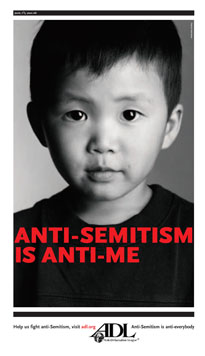 vehemently demanded the right to vote, think it was fine for African Americans to be denied this same right? It depends. My theory also includes the caveat that empathy for others does not always translate into citizens banding together for the greater good. Then again, the social evolution of the United States is progressing. This progression is the reason the language and message of equality remains relevant.
vehemently demanded the right to vote, think it was fine for African Americans to be denied this same right? It depends. My theory also includes the caveat that empathy for others does not always translate into citizens banding together for the greater good. Then again, the social evolution of the United States is progressing. This progression is the reason the language and message of equality remains relevant.
Equality is a shared goal that not everyone enjoys. Racial intolerance for one group is no different than bigotry for another. Denying equality for a particular group plays into the kind of discriminatory trap that makes no sense if one applies the very same principles of equality indiscriminately. All people are created equal, period.
The Declaration of Independence was written with the hope of possibility. Think about it—the signers of this document were declaring a new and independent country! 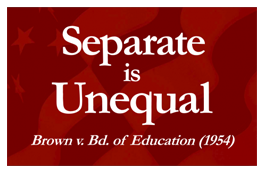 Jefferson’s words made a statement about human rights that became the foundation for a country unlike any other in the world. The signers never anticipated that their vision would eventually embrace so many different kinds of people, but that is the beauty of it. The Declaration was groundbreaking because it provided a foundation of principles and moral standards that have endured to modern times and that accommodate human evolution and its capacity for acceptance.
Jefferson’s words made a statement about human rights that became the foundation for a country unlike any other in the world. The signers never anticipated that their vision would eventually embrace so many different kinds of people, but that is the beauty of it. The Declaration was groundbreaking because it provided a foundation of principles and moral standards that have endured to modern times and that accommodate human evolution and its capacity for acceptance.
Stepping back and viewing all these posters as a whole, one could come to two conclusions. First: the human race does not learn from history. Second: humans 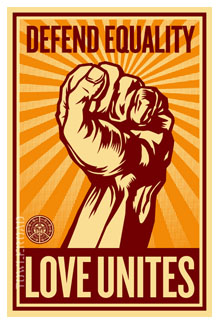 repeat the same mistakes over and over. However, I believe that the preservation and repurposing of the messages of protest in all their different forms are evidence that we do learn from history, and that we apply these tactics when the moment calls for them.
repeat the same mistakes over and over. However, I believe that the preservation and repurposing of the messages of protest in all their different forms are evidence that we do learn from history, and that we apply these tactics when the moment calls for them.
Similar to my previous posts on Race-Based Comedy and Race in Advertising, this post is a small glimpse into a bigger topic that welcomes further discussion. These subjects would be commonplace in a college syllabus, but is there any reason why we shouldn’t introduce dialogue about such issues into our daily lives? At the dinner table, instead of asking your kids how their day was at school and receiving a one-word answer, try bringing

By: yesisedit,
on 5/21/2012
Blog:
Yesisedit's Weblog
(
Login to Add to MyJacketFlap)
JacketFlap tags:
story,
Fun,
Thoughts,
Art,
politics,
nature,
science,
humor,
Photography,
Ideas,
Poem,
Children's book,
world,
Ecology,
help,
society,
Thank yous,
Say it ain't so,
1,
bail out,
Fair-e-tale,
Words can be funny,
Fuel for thought,
My view,
Add a tag

By: yesisedit,
on 3/17/2012
Blog:
Yesisedit's Weblog
(
Login to Add to MyJacketFlap)
JacketFlap tags:
politics,
science,
Photography,
Green,
world,
Ecology,
help,
Irish,
society,
Fair-e-tale,
St.Patrick's day,
Fuel for thought,
My view,
Thoughts,
Art,
nature,
Ideas,
Poem,
Thank yous,
Stories and art,
Food shortages a boom!,
Say it ain't so,
1,
childrens poems,
bail out,
Words can be funny,
story,
Fun,
Add a tag
With apologies to my ancestors, My interpretation of Skibbereen and post script.
They say it tis a lovely place, where in a saint might dwell,
so why did you abandon it father dear, the reason to me tell?
Oh son I loved my native land, with energy and much pride
‘Til a blight came over on my prats, my sheep and cattle died,
The rent and taxes were so high, I could not them redeem,
And that’s the true cruel reason why, I left dear old Skibbereen.
Oh, It’s sure I do remember, that bleak December day,
The landlord and the sheriff came, to drive us all away
They set my roof afire, with their cursed yellow english spleen
And that’s another reason why, I left dear old Skibbereen.
Your mother too, God rest her soul, fell on that snowy ground,
She fainted in her anguish, seeing the desolation laid all round.
She never rose, but passed away, from life to imortal dream,
She found a quiet grave, my boy, in dear old Skibbereen.
And you were only a wee young lad, and feeble was your frame,
I could not leave you with your friends, for you bore your father’s name,
I wrapped you in my overcoat , in the dead of night unseen
I heaved a sigh, and said goodbye, to dear old Skibbereen
o’ father dear, the day will come, when answer to the call
all Irish men of Freedom Stern, will rally one and all
ill be the man to lead the band, beneath the flag of green
loud and clear, well raise a cheer , remember Skibbereen
PS on St. Patrick’s day
The plight of the Irish immigrants who flooded the world in the time of potato famine
was caused as much by greed and prejudice as any lack of simple peasant food.
The poor Irish were driven from land by invaders, monetary greed, by taxes and starvation,
demonized like any culture the powerful wish to wash away so they may consolidate their power.
If scattered, the poor could not rise up, if not fed they would parish and be no threat.
Drunkenness is not the legacy my father gave to me, pride in my name and ancestory
of a race that will never give up or in until death takes me kicking to what lays beyond.
That is what my Father sang to me as his Father did to him.
John Murphy









By: yesisedit,
on 2/26/2012
Blog:
Yesisedit's Weblog
(
Login to Add to MyJacketFlap)
JacketFlap tags:
story,
Thoughts,
Art,
politics,
nature,
science,
Photography,
Ideas,
Poem,
world,
creation,
Ecology,
help,
belief,
insects,
choices,
society,
Thank yous,
Stories and art,
Say it ain't so,
1,
bail out,
Fair-e-tale,
Fuel for thought,
My view,
Life,
greed,
photo,
Future,
thought,
look,
political comment,
Add a tag
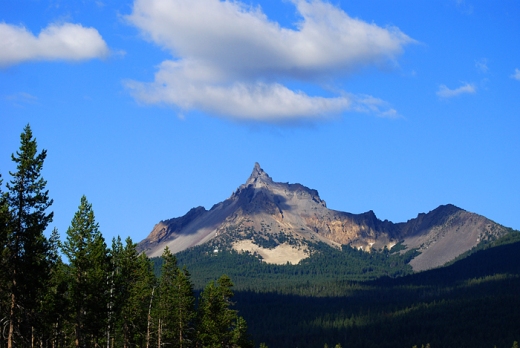 One of the, if not The, deepest questions of the universe.
One of the, if not The, deepest questions of the universe.
You have to start with what you believe is the force that is the creator of this life I believe.
Some think of GOD as a human type creature in who’s image we are created, with long flowing hair, robes to make him modest though he needs to hide nothing from his creations as I see it, and a celestial kingdom where he, or she in some cases, sits reining judgement down upon the works he designed and gave free will to.
I can not see that which created me in such limited form. I can not even envelope the concept of never ending or forever just because I am temporary in this form at least. I do however believe I was created from and by the “GOD” that has no limits and this is exactly why I think I am made in it’s likeness, BUT not in it’s totality, there are things missing if I am separate FROM God, God did not make me GOD, God, or even god, GOD made me human, GOD made everything else what it is too I believe but I think, like one atom in my body or even smaller than that, to infinity small, that part is still a part of GOD though never “GOD”, only a part, that the smallest part of me is still me, I am made in the likeness of and from GOD, I am alive, that smallest part of me is alive, GOD must also be alive if we are all part of everlasting life.
Conclusion; Life never begins, it is never ended, It IS!
Consciousness in itself does not prove to me that I am not alive.
The fact that when sperm and egg combine and the DNA messages combine to spark cell multiplication (The spark of life if you will) and a plan is put into affect to form a body which will make a human or any other living thing would seem to be life to me.
BUT it was life even before that! The EGG and the SPERM were also alive, donated by the life forms of at least two separate beings, who were made in the image of GOD, who is also alive.
GOD talks to all of us in GOD’s own way. Some hear “Him” like “He” was talking in their language and sitting having tea I suppose. Others see the “Great Spirit” manifest as all that surrounds us and all that can not be seen or even heard but that still is. I am more from that camp I suppose but still believe all is possible.
The right to life for me is hard to conceive when I believe that life is never ending. The right to life is not for me to tell you, you may or may not have though if you threaten my life I will not hesitate to use what ever is at my disposal to protect mine and stop yours!
The question to me is more the quality of the life you give rather than just letting all life happen. If all in creation is from GOD then even the worst of it is sacred and the Jaines may be correct and may have more in line with current Christian values than most think. But if we do not take into account what we offer, if a human is brought into this world through violent action that threatens the life that brings it who is the killer here? The mother who was raped or is too young and will surely die from the birth or the entity being born who would kill it’s mother, most assuredly it would be the rapist but can we take his life either? I would say it is not my place to judge any of these unless they are me. I WILL FIGHT FOR MY LIFE! But a Mother must make the call of giving herself for another in my view. It may seem selfish or unjust but it must be hers with as much help and support from all sides as she can get. Advise and support but not Judgement and in the end her decision as final carrier of that which will always be alive to enter into this world.
If you believe in eternal life you will not be sad for the soul who returns to it’s maker but wish it return another time

By: yesisedit,
on 12/12/2011
Blog:
Yesisedit's Weblog
(
Login to Add to MyJacketFlap)
JacketFlap tags:
story,
Fun,
Thoughts,
Art,
nature,
science,
humor,
Photography,
Ideas,
Children's book,
world,
help,
society,
Stories and art,
Say it ain't so,
1,
Fair-e-tale,
Words can be funny,
Fuel for thought,
My view,
Add a tag
This ones for all you scientist types out there, especially physicists, I learned string theory as a very young child and it goes like this, Very easy to get it!, When you are about 5 or 6 years old your mom sends you to the store to get some bread, milk and an avocado. As you travel through time ( it’s a long way to the store, perhaps 2 blocks) you look at your finger where your mom tied that string so you would remember the milk, avocado and something that started with a B, must have been bubble gum. As you pass through space you are getting bored so use the string to tie on a cat’s tail so she will remember to go home, this causes almost immediate warp drive on the part of the cat at least and a ton of amusement and wonder for you. Now you find that you have passed the store and lost a bunch of time (Time warp is discovered) but you turn your self around and make it to the store and pick up Bubble gum, malt and an Abazaba and head for home. You find that it is taking way too much of your time so you look for a black hole (Convenient alley will do with a hole in the fence, yet another scientific find) as you arrive you find your mother pacing and an argument ensues as to what the string theory meant and no one agrees (just like modern science!).










By: yesisedit,
on 12/9/2011
Blog:
Yesisedit's Weblog
(
Login to Add to MyJacketFlap)
JacketFlap tags:
society,
Thank yous,
Stories and art,
Say it ain't so,
1,
bail out,
Fair-e-tale,
Words can be funny,
Fuel for thought,
My view,
story,
Fun,
Thoughts,
Art,
politics,
nature,
humor,
Photography,
Ideas,
Children's book,
world,
Ecology,
help,
Add a tag

By: yesisedit,
on 12/5/2011
Blog:
Yesisedit's Weblog
(
Login to Add to MyJacketFlap)
JacketFlap tags:
bail out,
Fair-e-tale,
Words can be funny,
Fuel for thought,
My view,
story,
Fun,
Thoughts,
politics,
nature,
humor,
Photography,
Ideas,
world,
Ecology,
society,
Say it ain't so,
1,
childrens poems,
Add a tag

By: yesisedit,
on 11/22/2011
Blog:
Yesisedit's Weblog
(
Login to Add to MyJacketFlap)
JacketFlap tags:
story,
Fun,
Thoughts,
Art,
nature,
humor,
Ideas,
Children's book,
world,
society,
Stories and art,
Say it ain't so,
1,
childrens poems,
bail out,
Fair-e-tale,
Words can be funny,
Fuel for thought,
My view,
Add a tag

By: yesisedit,
on 11/6/2011
Blog:
Yesisedit's Weblog
(
Login to Add to MyJacketFlap)
JacketFlap tags:
story,
Fun,
Thoughts,
Art,
nature,
Ideas,
space,
ocean,
Future,
world,
moon,
time,
help,
thought,
aliens,
sky,
society,
Stories and art,
Say it ain't so,
1,
Fair-e-tale,
Words can be funny,
Hap Murphy,
past,
Fuel for thought,
My view,
extra terrestrial,
Life,
Add a tag
Once during a time before this time there was an advanced group of people living on what is now called earth. They were advanced enough to be in the beginnings of off world flight and living for extended ages in the quite of space. These people had several colonies on outer planets and were mining comets for iron to build fantastic ships that would support large colonies for ages in flight to other galaxies.
By the time they had 3 expeditions launched the earth was pretty depleted of those who were capable of living off planet even with their work in the nano-health sciences making the remaining population live longer and healthier, the greatest of their minds had opted for the grand travel in search of new worlds and higher learning.
As the last, as it turned out, star ship was leaving the galactic boundaries it learned of a catastrophe about to send solar debris toward earth in a massive wave that was more than the inhabitants could overcome and an almost complete annihilation of life on earth would happen but because they would be drawn in and also destroyed if they tried to reverse course to help, they stayed their course and the ships leader General Odessa Davis sent word to the other outbound vessels of the destruction and that he and his crew would go into dormancy except for the AI and robots who could carry out advanced scientific studies that could be fed into the human bodies as they rested in stasis and would come out after a period of time when it was again safe to venture back to help what ever was left of society in the solar system.
After many eons Davis was awakened, fully rejuvenated by the internal bot-medics, his DNA advanced and most known human physical problems dealt with. His crew as well had been resurrected to a much advanced state of physical ability. The AI was far advanced but still willing to be part of “The new humanity”.
On returning to Earth they found all the outposts along the way had suffered total annihilation and only Earth was left with life but not human in nature. Only larger land animals and ocean creatures lived well but were in an altered state from the creatures who the space dwellers had left behind before the destruction of the planets they knew as home.
The land masses had turned under in the violence and no sign of the former intelligence was in evidence beyond things that were rusting beyond recognition or were soon to be abducted under the volcanic eruptions still roiling upon the surface.
General Odessa Davis’ crew was small compared to the other colony ships human cargo but it had wide diversity in genetic standing. It was agreed that a new human society was to be created on this “New” Earth and their ship would explore the outer reaches of this galaxy while it naturally built itself with no artificial intelligence help.
Science Administrator Thomas Alvin Nester was assigned to find suitable earth hosts for DNA from the ships ancient cold storage to start the new humans on the planet. A few examples where gathered from warm blooded species that could simulate human form though not so close as to copy human form as it was in the past and the most dangerous animals that would be a hazard to these prototype “New lifers” would be eliminated using low tech asteroid bombardment which would also rearrange the world to have more water segregated continents for the experiment to give more chances one would work in favor of a new society that would eventually be allowed to carry on the work of the ancients in outer space while giving diversity to the human body form.
S.A.Thomas A. Nester or as his suit tag read S.A.T.A.N. was told to give the subjects only pure original DNA because G. O. Davis wanted Independent natural growth before any advanced knowledge was invested in this new human experiment. But Nester thought he knew more about science and what should be the new form of things than the General and allowed advanced knowledge to be a

By: Maryann Yin,
on 2/1/2011
Blog:
Galley Cat (Mediabistro)
(
Login to Add to MyJacketFlap)
JacketFlap tags:
Young Adult Books,
society,
dystopian fiction,
How to Find an Agent,
love story,
trilogy,
arranged marriages,
Dutton Children's Books,
Matched,
Ally Condie,
game theory,
the prisoner's dilemma,
Add a tag
 Ally Condie (pictured, via) published several books before she came out with her recent New York Times bestseller, Matched.
Ally Condie (pictured, via) published several books before she came out with her recent New York Times bestseller, Matched.
We caught up with the author to find out how she landed an agent for her young adult manuscript–straight from the slush pile. We also found out what it takes to write dystopian fiction for a YA audience. Highlights from the interview follow below.
Q: How did you find your agent?
A: I sent out queries to agents who represented young adult fiction. I found their names online at agentquery.com and then researched them at Publishers’ Marketplace and online to make sure they would be a good fit (i.e., I wasn’t sending young adult fiction to those who didn’t represent it!). A friend clued me in to all of these websites—things had changed a bit since I originally queried my first book in 2004!
continued…
New Career Opportunities Daily: The best jobs in media.

By: yesisedit,
on 1/17/2011
Blog:
Yesisedit's Weblog
(
Login to Add to MyJacketFlap)
JacketFlap tags:
story,
Fun,
Thoughts,
Art,
politics,
nature,
humor,
Photography,
Ideas,
Poem,
world,
Ecology,
help,
insects,
society,
Thank yous,
Stories and art,
Food shortages a boom!,
Say it ain't so,
1,
bail out,
Fair-e-tale,
Words can be funny,
Fuel for thought,
Hati,
My view,
The gulf of Mexico,
Add a tag
Tired of politics as usual? …
Want real change ? …
Want a representative in office who really cares for you? …
Want a representative who is loyal and will obey your wishes ? …
Want truth in what he thinks about current representation ? …
Wyatt T. Dawg is the one for you !
He calls it like he sees it !
He is the most HONEST representative you can find !
He will be LOYAL to you no matter what the situation is !
He is not looking to get rich or benefit himself over you !
He will stand guard for your freedoms through any situation !
Wyatt T. Dawg uses common since to get things done
and knows a crook when he smells one.
Make him your choice for any position and you will feel you have done yourself justice.
He will let your opinion be known in the halls and in the country,
anywhere he feels there is something to be said.
His family has gone to war, protected us at home and in police duties.
His party will be a friend who watches out for you!
Vote for Wyatt T. Dawg !!!
This add Not paid for by anyone ! But supported by the “Loyal Dawgs” party
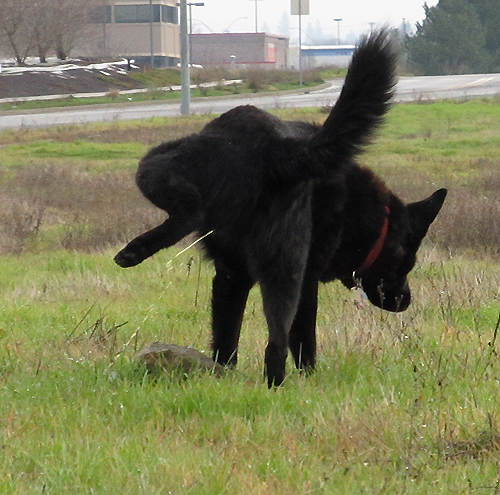









By: yesisedit,
on 11/29/2010
Blog:
Yesisedit's Weblog
(
Login to Add to MyJacketFlap)
JacketFlap tags:
story,
Fun,
Thoughts,
Art,
politics,
nature,
humor,
Photography,
Ideas,
Children's book,
help,
Thank yous,
Stories and art,
Say it ain't so,
1,
bail out,
Fair-e-tale,
Words can be funny,
Life,
friends,
photo,
love,
flowers,
Future,
funny,
world,
play,
Ecology,
time,
thought,
society,
look,
weed,
political comment,
Hap Murphy,
Fuel for thought,
My view,
Add a tag
I know some people, not to mention names, who are like old teasel.
They grumble and rumble and sometimes grumble about their rumble.
At times their age shows in the form of sharp barbs and spotted faces.
But I would not trade them for any other because you see they are still beautiful to me.
They are still like that quick young person I knew when they get sassy and say things that others may fear to say.
But now they don’t whisper it and come right out loud and say it to my face.
When they put on a new hat they are still handsome, though in a more dignified way even if some of them don’t pick the best look, they never did then either.
Yup! they may be old and slow and have weaker eyes to see all my imperfections with but I still got um and maybe my barbs are showing a bit more too.
I think all those young and brash weeds I knew may not be young in the eyes of the world but I still see them fresh and green with high hopes.
I try to listen more to what they have to say too because the older I get the more there is to know.
Young weeds tell me what they think is right, and where they think I should go and how I should go because they read it in a book but old thistles tell me from experience what’s really in store for me because they wrote the book.










By: yesisedit,
on 11/23/2010
Blog:
Yesisedit's Weblog
(
Login to Add to MyJacketFlap)
JacketFlap tags:
1,
Fuel for thought,
childrens poems,
My view,
Ideas,
world,
Art,
nature,
story,
Photography,
Stories and art,
Thoughts,
society,
Say it ain't so,
Ecology,
Food shortages a boom!,
Add a tag

By: Kirsty,
on 10/27/2010
Blog:
OUPblog
(
Login to Add to MyJacketFlap)
JacketFlap tags:
Victorian,
A-Featured,
A-Editor's Picks,
homeless,
Prose,
society,
OWC,
Early Bird,
streets,
henry mayhew,
london labour and the london poor,
robert douglas-fairhurst,
mayhew,
History,
Literature,
UK,
london,
Add a tag
By Robert Douglas-Fairhurst
It was an ordinary enough London winter’s evening: chilly, damp, and churning with crowds. I’d arranged to meet a friend at the Curzon Mayfair cinema, and after my packed tube had been held up between stations – ten sweaty minutes during which my fellow passengers had fumed silently, tutted audibly, and in one or two cases struck up tentative conversations with the person whose shopping was digging into their shins – I was late. Coming out of the entrance to the station, I nimbly side-stepped a beggar with a cardboard sign – sorry, bit of a rush, direct debit to Shelter, can’t stop – and hurried on my way to the cinema.
The film was Slumdog Millionaire: a nerve-shredding if ultimately cheering investigation into the hidden lives of the Indian slums. Coming out of the cinema, though, it was impossible to avoid the realiszation that equally vivid stories lay much closer to home. I retraced my steps to the tube station, and this time instead of brushing the beggar off I listened to what he had to say. It was a sadly familiar account of alcohol, a broken marriage, and homelessness, but as he told it the events took on a vividly personal colouring that was new and strange. He made me look again at what I thought I already knew.
The idea that what takes place under our noses can be hard to see clearly is hardly an original one; indeed, anyone who lives in a city soon learns to recognize the sensation of life being jolted out of its familiar routines, and assumptions being rearranged by new experiences. However, this idea took on a new resonance a few weeks later, when I was asked to edit a new selection of London Labour and the London Poor, Henry Mayhew’s mammoth set of interviews with the street-sellers, beggars, entertainers, prostitutes, thieves, and all the rest of the human flotsam and jetsam that had washed up in the capital during the 1840s and 1850s.
Ask most readers – and not a few critics – who Henry Mayhew was, and the result is likely to be at best a puzzled stare. Though his voice pops up occasionally in recent work, from Philip Larkin’s poem ‘Deceptions’ to novels such as Michel Faber’s The Crimson Petal and the White, for the most part he has become the Invisible Man of Victorian culture. And like H. G. Wells’s hero, usually he is detectable only by the movements of his surroundings, from Charles Kingsley’s jeremiad against the exploitation of cheap tailors in Alton Locke, to the strange echoes of his interview subjects in characters like Jo in Dickens’s Bleak House.
In some ways these literary aftershocks and offshoots of London Labour and the London Poor accurately reflect the work’s own generic hybridity. Opening Mayhew’s pages, it is hard to escape the feeling that you are encountering a writer who has one foot in the world of fact, one foot in the world of fiction, and hops between them with a curious mixture of uncertainty and glee. Sober tables of research are interrupted by facts of the strange-but-true variety: ‘Total quantity of rain falling yearly in the metropolis, 10,686,132,230,400 cubic inches’, or ‘The drainage of London is about equal in length to the diameter of the earth itself’. Even cigar-ends don’t escape his myth-making tendencies. Not content with calculating the number thrown away each week (30,000) and guessing at the proportion picked up by the

By: shelf-employed,
on 7/25/2010
Blog:
Shelf-employed
(
Login to Add to MyJacketFlap)
JacketFlap tags:
YA,
history,
love,
book review,
historical fiction,
romance,
family life,
coming of age,
Pennsylvania,
sisters,
disasters,
books in verse,
society,
floods,
social classes,
coal miners,
Add a tag
Richards, Jame. 2010.
Three Rivers Rising: A Novel of the Johnstown Flood. New York: Knopf.
This book debuted in April 2010 to well-earned,
rave reviews. In sparse verse, author Jame Richards, tells a story of devoted high society sisters, Celestia and Estrella, Whitcomb, their coldly calculating, businessman father, a miner's son, Peter, Maura, the wife of a Pennsylvania railroad engineer, and Kate, an obsessive-compulsive young widow struggling to find a purpose in life. Their lives become intertwined due to the tragically preventable Johnstown, Pennsylvania flood of 1889. Chapters of free-form verse alternate between the voices of the six characters. An author's note separates the facts of the actual flood from the story. More than 2200 people died in the flood, including entire families.
The Johnstown Flood is the backdrop, but
Three Rivers Rising is foremost a story of society, class, and first (or forbidden) love.
Highly recommended for grades 8 and up.
A
reader's guide is available for teachers, librarians and book clubs.
The aftermath of the Johnstown Flood.
(Photograph from
Wikimedia Commons, originally taken by an employee of the National Oceanic and Atmospheric Administration.)

By: yesisedit,
on 6/17/2010
Blog:
Yesisedit's Weblog
(
Login to Add to MyJacketFlap)
JacketFlap tags:
Fuel for thought,
My view,
The gulf of Mexico,
Life,
Food,
Work,
story,
Photos,
Fun,
greed,
photo,
love,
flowers,
Thoughts,
Art,
politics,
nature,
humor,
Photography,
Ideas,
Color,
Poem,
Money,
Children's book,
Future,
funny,
world,
play,
bugs,
Ecology,
time,
help,
thought,
insects,
Correct,
sky,
colorful,
society,
economy,
Thank yous,
Stories and art,
Food shortages a boom!,
Say it ain't so,
Grain,
Murphy,
1,
look,
weed,
childrens poems,
political comment,
bail out,
Fair-e-tale,
Words can be funny,
Hap Murphy,
Add a tag

By: yesisedit,
on 6/17/2010
Blog:
Yesisedit's Weblog
(
Login to Add to MyJacketFlap)
JacketFlap tags:
story,
Thoughts,
Art,
Photography,
Ideas,
world,
society,
Thank yous,
Stories and art,
Say it ain't so,
1,
Fuel for thought,
My view,
Add a tag

By: yesisedit,
on 6/8/2010
Blog:
Yesisedit's Weblog
(
Login to Add to MyJacketFlap)
JacketFlap tags:
ocean,
pollution,
Money,
Children's book,
Future,
world,
Ecology,
time,
help,
thought,
Oil,
recycle,
society,
economy,
Thank yous,
Stories and art,
Food shortages a boom!,
Say it ain't so,
1,
look,
childrens poems,
tourists,
political comment,
bail out,
Fair-e-tale,
honest,
solution,
trash,
pay,
Fuel for thought,
My view,
BP,
gulf,
The gulf of Mexico,
blame,
honestly,
barriers,
dredge,
floating,
Life,
Food,
Work,
story,
Photos,
Fun,
greed,
photo,
love,
Thoughts,
Art,
politics,
nature,
animals,
Photography,
Ideas,
Mexico,
Poem,
Add a tag
 As we are busy blaming “BP” for messing up the Gulf of mexico I would suggest a solution for oil barriers along the beautiful beaches there and in fact all along our coastlines. First I will direct you to search floating “debris in the gulf of Mexico”.
As we are busy blaming “BP” for messing up the Gulf of mexico I would suggest a solution for oil barriers along the beautiful beaches there and in fact all along our coastlines. First I will direct you to search floating “debris in the gulf of Mexico”.
There are enough objects floating there that if gathered and strung along the beaches could cover all the coastlines of our country I believe. It is floating so we would not have to buy new floating barriers, all we need is nets, which could be made from shredding more of the junk out in the ocean. “BP” didn’t put it there, it came from the cities along the waterways that feed into the gulf.
Though much of it is oil byproducts washed out from storm drains, a lot came from the “Beautiful” beaches and those “Valuable tourists” that are so afraid of getting a tar ball on their tootsies visited and left behind. They should come back and volunteer to help clean it if they really care!
I also propose instead of dredging sand that will destroy animal habitat we build berms of the garbage that came from those beaches in the first place. It may be ugly, to say the least, but it would do more for the fish and birds in the region that get trapped in it than any other thing I can think of, just cover it with a small portion of sand from the tourist beaches.
The wild life doesn’t want it and it’s only fare that the people that made it take it back and recycle it or something. They need to pay for every bit of the pollution just like “BP”, all of us who let that junk float out to sea should pay for it to be cleaned up!
If an honest look at what is in the ocean was taken “BP” would look like small potatoes or in this case oil byproduct pollution.








By: Kirsty,
on 4/28/2010
Blog:
OUPblog
(
Login to Add to MyJacketFlap)
JacketFlap tags:
broken britain,
election,
state,
society,
evacuation,
History,
UK,
Politics,
Current Events,
A-Featured,
conservation,
Early Bird,
john welshman,
Add a tag
The phrase ‘Broken Britain’ is well known to British newspaper readers; it’s a phrase commonly used across the media to describe society’s problems. In the blog post below historian John Welshman, author of Churchill’s Children, traces this identification of a broken society back to around the time of the Second World War, and argues that the real answer is – and was then – to address society’s inequalities rather than ‘Big Society’ and a retreat from state involvement.
You can read John Welshman’s previous posts here. A longer version of this post will appear on the History & Policy website at a later date.
The mantra of ‘Broken Britain’ has been a potent theme for the Conservative Party, its definition effortlessly broadening to encompass whatever appears to be the anxiety of the moment. Iain Duncan Smith has produced an analysis of social breakdown that has five main strands: first, anxiety that a ‘problem’ exists; second, a focus on ‘pathways’ to poverty, covering family breakdown, economic dependency, educational failure, addiction, and personal indebtedness; third, an emphasis that this is ‘lifestyle’ poverty, and not just about money; fourth, a belief in the responsibilities of parents and on the family as the foundation of policy; and fifth, the claim that people themselves, and the voluntary sector, hold the solution. Similarly, the Party’s manifesto argues that a new approach is needed to tackle the causes of poverty and inequality, focusing on social responsibility rather than state control, and on the ‘Big Society’ rather than big government. Only in this way, it is claimed, can ‘shattered communities’ be rebuilt, and the ‘torn fabric’ of society be repaired.
But the identification of a broken society, and these solutions, while current, are nothing new. For exactly the same themes were the subject of debate during the Second World War. In September 1939, carefully-laid plans were put into action, and 1.5m adults and children were evacuated from Britain’s cities to the countryside. If those mothers and children evacuated privately are added to the total numbers, some 3.5 to 3.75m people moved altogether. Those evacuated from England in September 1939 comprised 764,900 unaccompanied schoolchildren; 426,500 mothers and accompanied children; 12,300 expectant mothers; and 5,270 blind people, people with disabilities and other ‘special classes’. The largest Evacuation Areas for unaccompanied schoolchildren (apart from London) were Manchester (84,343); Liverpool (60,795); Newcastle (28,300); Birmingham (25,241); Salford (18,043); Leeds (18,935); Portsmouth (11,970); Southampton (11,175); Gateshead (10,598); Birkenhead (9,350); Sunderland (8,289); Bradford (7,484); and Sheffield (5,338). In Scotland, the largest Evacuation Areas, in terms of accompanied children, were Glasgow (71,393); Edinburgh (18,451); Dundee (10,260); Clydebank (2,993); and Rosyth (540). Given this emphasis upon place, unsurprisingly the evacuation was followed by an outpouring of debate about the state of urban Britain.
It is true that the revolution that took places in English fields and villages seventy years ago was a quiet one. There were much continuity, for instance, in policy between the 1930s and 1940s. Even after the evacuation, civil servants still clung to entrenched attitudes, and continued to put their faith in education, so that Government circulars still tended to emphasise the responsibilities of parents, and to rely on the resources of voluntary organisations. Moreover the pathologising of families remained part of the discour

By: Fernanda Cohen,
on 4/13/2010
Blog:
Illustration Friday Blog
(
Login to Add to MyJacketFlap)
JacketFlap tags:
Interviews,
new york,
artists,
lecture,
illustrators,
coe,
society,
events and openings,
sue,
Add a tag

I’ll be moderating Sue Coe’s lecture at the SI this Wednesday. As I’m sure EVERYONE knows here, she’s a brilliant mind in our field and I can’t wait to meet her in person and hear what she has to say.
Hope you can make it!
http://societyillustrators.org/upcoming/coe.cms
Fernanda

By:
Darcy Pattison,
on 3/4/2010
Blog:
Darcy Pattison's Revision Notes
(
Login to Add to MyJacketFlap)
JacketFlap tags:
conflict,
friends,
Picture book,
novel,
picture books,
nature,
plot,
revise,
Society,
self,
how to write,
Add a tag
Conflict, the type that motivates and moves a plot, comes from four sources.
Yesterday, an editor asked for revisions on a very short piece which was meant for a kindergarten or first grade audience. The editor didn’t like the competitiveness between siblings. But when she contemplated taking out that conflict, she correctly understood that the story lacked something. Could I fix it, she asked.
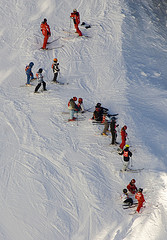 Of course, my first reaction was, “Don’t edit out that conflict!”
Of course, my first reaction was, “Don’t edit out that conflict!”
But it’s always unhelpful to try to protect your words and ideas from the collaboration of an editor who knows her audience. So, I sat and thought about the story. Sometimes, you just need to apply what you already know, and I know that there are four types of conflict in a story:
- Conflict with Society. This is a quiet story and it simply didn’t have elements that would allow this option.
- Conflict with Someone Else. That conflict had been ruled out by the editor. I might could have found some other way to include conflict, but my feeling was they wanted a gentle but fun story, without that kind of interpersonal conflict.
- Conflict with Self. I already had the character trying something very difficult and sticking with it.
- Conflict with Nature. Ah, maybe I could add in just the briefest touch of this type conflict. The main character’s task could be considered as a struggle against nature.
In the end, I added a line near the beginning that hinted at conflict with nature, then a line at the end which resolved it.
In the meantime, I tried to add a touch of humor in a couple other exchanges.


By: yesisedit,
on 1/17/2010
Blog:
Yesisedit's Weblog
(
Login to Add to MyJacketFlap)
JacketFlap tags:
thought,
insects,
Oil,
rabbit,
sky,
colorful,
society,
fable,
economy,
Thank yous,
Stories and art,
Food shortages a boom!,
Say it ain't so,
Grain,
Murphy,
1,
look,
weed,
childrens poems,
political comment,
bail out,
Fair-e-tale,
Words can be funny,
Hap Murphy,
jackrabbit,
Fuel for thought,
My view,
fairytail,
Life,
Food,
Work,
story,
Photos,
friends,
Fun,
greed,
photo,
love,
flowers,
Thoughts,
Art,
drawing,
politics,
nature,
animals,
humor,
Photography,
Ideas,
mouse,
Color,
Poem,
turtle,
ocean,
Money,
Children's book,
bunny,
Future,
funny,
world,
mice,
play,
bugs,
fire,
horses,
hare,
Aesop,
tortoise,
time,
help,
Add a tag
The old tale of Tortoise and Hare tells that falling asleep while doing a task is bad.
Jack the rabbit read it well, thought to himself, “the light this sheds is sad !”
No member of my global community is so lax, I’ll get that title back !
To that end he checked out the local Tortoise, Goggling on his computer for every fact.
He bought goggles and bomber cap from a site on the internet .
And while he was at it, found some sites and placed a few side bets.
The odds were good, in the turtles favor.
The money Jack knew he would soon savor !
Come race day the a crowd came out and the sun did shine.
The Tortoise was ready and Jackrabbit looked quite fine !
The race got started with a flurry and flash.
The rabbit was off like a shot but Tortoise got hung up in desert trash.
Jack was far out in front and in sight of the finish line .
But Coyote spied the race, thinking Tortoise and Hare would taste just fine.
Coyote joined in the race with turtle the first one he caught just rounding the bend.
Tortoise pulled up shy in his shell and, though Coyote knocked, would not let him come in.
So off Coyote sped to catch his other pray but Jack saw him coming and did not want to be Din Din.
As things often go the race was a bust and no body won.
Jack was diligent and did not sleep, so lived to have another son.
Tortoise, though he was slow, lived long and finally came out.
But Tortoise forgot what the race was about.
So when you hear another famous fable.
Just finish your spinach and clean up the crumbs before you leave the table.
So you may live long like Tortoise and Hare,
Though like Tortoise your mind may not be there.
And fast is good when you are fast as a bunny so you may outrun the danger.
Like Jackrabbit, you may have to change your course when chased by a stranger.








By: yesisedit,
on 1/14/2010
Blog:
Yesisedit's Weblog
(
Login to Add to MyJacketFlap)
JacketFlap tags:
story,
Thoughts,
politics,
nature,
Ideas,
world,
help,
society,
Thank yous,
Food shortages a boom!,
Say it ain't so,
1,
bail out,
Fuel for thought,
Hati,
My view,
Add a tag
First … I think it is imperative we help the peoples of Haiti, no ifs ands or buts !!!
Secondly however … I think the people of Haiti need some major educational efforts along with a way to make a living and not from tourism !!!
Food is basic to stability in any society. When the populace eats enough that they have a little time to put forth extra efforts they usually come up with good Ideas to keep growing. If hunger keeps them on a constant search to fill bellies with no education on productive farming practices you get things like denuded hillsides, eroded ground, poor soil stability and ever poorer quality of land that eats away at itself in an ever spiraling downward cycle until the populace is always in flux and no political system can last, giving way to warlords and crime in general.
The earthquake in Haiti can be a positive thing if more than money is poured in just so people feel good about helping. It must be made to work for the common good of all these people as in ways to create potable water in a manner that is sustainable by relatively low levels of education. Agricultural practices that lead not to large commercial Agra-business but small plot farming. Micro investment so the populace can make extra money or even sustain a family and rebound even with natural disasters that seem to hit this part of the world .
Education more than just primary, though that seems to be badly needed as well, where the region can have native knowledge that will grow to help itself with forethought to that which is possible for building society and structures that will be safe. The populace needs to be put to work in the reconstruction efforts, not companies brought in from somewhere else, so cultural elements will be understood. At first this may need to be overseen by outside help (show them how to build , don’t build it for them) but only until educated native elements can be found or educated to take over and NO LONGER!
A government that is of the peoples choice, even if we do not like it, should be supported and worked with to stabilize it in a world culture as legitimately wanted and promote aid in ways that do not force political agendas but aim at the well being of common citizens. Care should be taken that the help does not end up in the pockets of a few elite .
We and they will be all the better for this kind of help and some day we may indeed be helped by them in return.






View Next 8 Posts



 Independence ”that all men are created equal,” and over time equal rights have been gradually extended to different groups of people. However, equality has never been achieved without heated debate, despite our country’s founding principle that all people are created equal in the first place.
Independence ”that all men are created equal,” and over time equal rights have been gradually extended to different groups of people. However, equality has never been achieved without heated debate, despite our country’s founding principle that all people are created equal in the first place. vehemently demanded the right to vote, think it was fine for African Americans to be denied this same right? It depends. My theory also includes the caveat that empathy for others does not always translate into citizens banding together for the greater good. Then again, the social evolution of the United States is progressing. This progression is the reason the language and message of equality remains relevant.
vehemently demanded the right to vote, think it was fine for African Americans to be denied this same right? It depends. My theory also includes the caveat that empathy for others does not always translate into citizens banding together for the greater good. Then again, the social evolution of the United States is progressing. This progression is the reason the language and message of equality remains relevant. Jefferson’s words made a statement about human rights that became the foundation for a country unlike any other in the world. The signers never anticipated that their vision would eventually embrace so many different kinds of people, but that is the beauty of it. The Declaration was groundbreaking because it provided a foundation of principles and moral standards that have endured to modern times and that accommodate human evolution and its capacity for acceptance.
Jefferson’s words made a statement about human rights that became the foundation for a country unlike any other in the world. The signers never anticipated that their vision would eventually embrace so many different kinds of people, but that is the beauty of it. The Declaration was groundbreaking because it provided a foundation of principles and moral standards that have endured to modern times and that accommodate human evolution and its capacity for acceptance. repeat the same mistakes over and over. However, I believe that the preservation and repurposing of the messages of protest in all their different forms are evidence that we do learn from history, and that we apply these tactics when the moment calls for them.
repeat the same mistakes over and over. However, I believe that the preservation and repurposing of the messages of protest in all their different forms are evidence that we do learn from history, and that we apply these tactics when the moment calls for them.





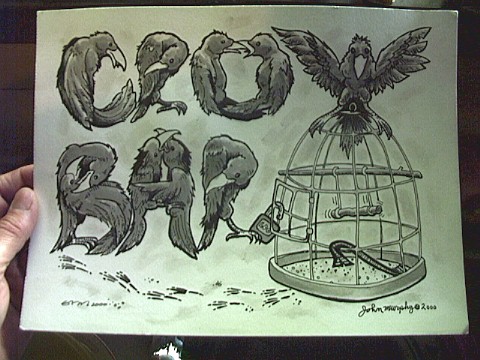

 Ally Condie (pictured,
Ally Condie (pictured, 













 Of course, my first reaction was, “Don’t edit out that conflict!”
Of course, my first reaction was, “Don’t edit out that conflict!” 



Your poem touched me. My ancestors were Scottish, not Irish, but they shared much the same fate when leaving the old world for the new. Thank goodness for America where our peoples have flourished.